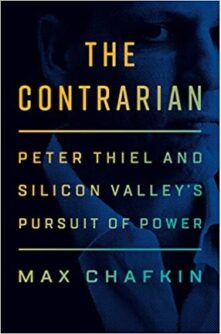
Bloomberg Businessweek reporter Max Chafkin’s new The Contrarian: Peter Thiel and Silicon Valley’s Pursuit of Power offers insight into the interesting Thiel himself, the ascendancy of Silicon Valley more generally—in both concept and practice, and economically, culturally, and politically—and the rigorous intellectual and political debates within conservatism, roiling more seriously since 2016. Some valuable insights into philanthropy can also be gleaned from it.
Thiel co-founded PayPal in 1998, Palantir Technologies in 2004, and the San Francisco-based Founders Fund venture-capital firm in 2005, among other things. He became the first outside investor in Facebook in ’04, he backed the lawsuit that bankrupted Gawker Media and endorsed Donald Trump’s presidential candidacy in ’16, and he has an estimated current net worth of almost $7.25 billion.
Chafkin’s generally not flattering book references several of Thiel’s philanthropic and nonprofit-group interests in research on precluding the negative aspects of aging and promoting “seasteading.” After briefly describing Thiel’s support of a nonprofit that would immortalize us in software, Chafkin writes, “To the extent that these donations attracted mockery, he now seemed to welcome it.”
The Contrarian also specifically notes the foundation-funded Intercollegiate Studies Institute’s (ISI’s) grants to The Stanford Review—a boldly conservative, satirical campus publication that Thiel co-founded while an undergraduate at Stanford in 1987. “It was his first entrepreneurial venture and would include the first nodes of a network that would come to dominate Silicon Valley,” according to Chafkin. Good grantmaking.
Chafkin quotes Thiel’s editor’s note from the Review’s inaugural issue: “A vocal few have succeeded in dominating the discussion, often with views very different from those of the Stanford mainstream,” the young Thiel wrote. “Many of the more moderate students in the Stanford community remain silent, believing that it makes little difference whether they speak out or not.”
Later, as Chafkin reports, Thiel’s first book The Diversity Myth: “Multiculturalism” and the Politics of Intolerance at Stanford was publicized with the help of a $40,000 John M. Olin Foundation grant to the Independent Institute. Another good grant.
Co-authored with Thiel’s fellow Stanford graduate David O. Sacks and first released in 1996, Thiel stood in front of the Stanford student union with a giant stack of copies and handed them out to anyone who walked by and would accept one. Bold grant recipient there.
The Contrarian dwells at a little more length on the subsequent Thiel Fellows program. The program grew out of a Founders Fund partnership that gave out $50,000 “Genius Grants for Geeks” to promising young tech-startup figures, as Chafkin tells it. In 2010,
Thiel was adding a twist. The New “20 Under 20” program would be limited to teenagers, and it would be entirely philanthropic. They would call the young entrepreneurs Thiel Fellows, and the grants would come with no strings attached. The only condition was that they would have to drop out of school ….
Yet again, bold—creatively (close to comically, actually) and provocatively underscoring a point, which Thiel had long been making, about the value of higher education.
[caption id="attachment_76871" align="alignnone" width="342"] Chafkin (YouTube)[/caption]
Chafkin (YouTube)[/caption]
In March 2011, Chafkin recounts, Thiel flew 44 teenagers and their parents to San Francisco to “present ideas, listen to talks, mingle with … the PayPal Mafia, and compete with one another to be one of” the Thiel Fellowship’s inaugural cohort. (Since 2015, the project has allowed for fellows up to the age of 22.)
Later in ’11, the Thiel Foundation “released the list of names of twenty-two men and two women who would be dropping out of some of the nation’s most prestigious universities”—Harvard, MIT, Stanford, and Yale among them—for $100,000 over two years.
“Thiel hired a local film crew to follow the first group, producing short documentaries that glorified the project” and “partnered with a friendly journalist … to write a book about the project,” continues Chafkin, who doses his description with pages of panning of the motives underlying its creation and its initial implementation.
“Thiel’s image needed a rebrand” after the Founders Fund was struggling to bring in new investors and his own “recent investments hadn’t looked so hot either,” according to The Contrarian.
The fellowship, and the accompanying media push, constituted a major element of Thiel’s attempt to change his public perception. He’d spent the early 2000s playing a role that wasn’t his—the heterosexual, high-living hedge fund manager—now he was fashioning a new character: a bold, risk-taking investor with a burning desire to blow up the system.
One should wonder whether it’s the boldness that Chafkin wants to characterize as so new, or even the system blowing-up. His bio shows they’re really not new, no? One could wonder, moreover, whether other grantmakers ever consider certain grants’ point-making purposes basically met on the day they’re announced.
But wait, there’s more. The afterthought of an actual project was poorly planned and disastrous for some of the fellows, only a few of whom have found success in their number of years since, Chafkin writes. It was overhyped, unstructured, and staffed by unqualified people, he says, citing and anonymously quoting former fellows.
Chafkin says he “heard of an early Thiel Fellow who seemed to be wrestling with mental health issues and drug addiction, but, according to two early fellows, administrators were slow to intervene.” One might wonder whether there could ever be a similarly sad story or two, or even just similarly roundabout suggestions of one, arising from any (selective?) analysis of, say, the MacArthur Fellows program.
Burningly desire to “blow up the system” or change its rules, and your projects will be panned?
There are risks to boldness, and this kind of criticism is, and probably should be, one of them. It may be acceptable to a lot of donors—perhaps especially ones like Olin and Thiel and those who support ISI in particular, along with some liberal and progressive equivalents.
In general, many think risks are probably better borne by private foundations than, say, corporations or government. The conceptual justification for and legal framework of nonprofitdom is consciously consistent with that line of thinking. Since there may be benefits to taking these risks, it goes, let rich givers take them.
Contemporary establishment philanthropy in the country is overwhelmingly monocultural and risk-averse. Parts of Chafkin’s biography of Thiel begin to hint at a different route that could and should instead be considered, relevant to any institutions and individuals interested in good giving.
Alternatively—in this case, categorized as conservative—and boldly contrarian.